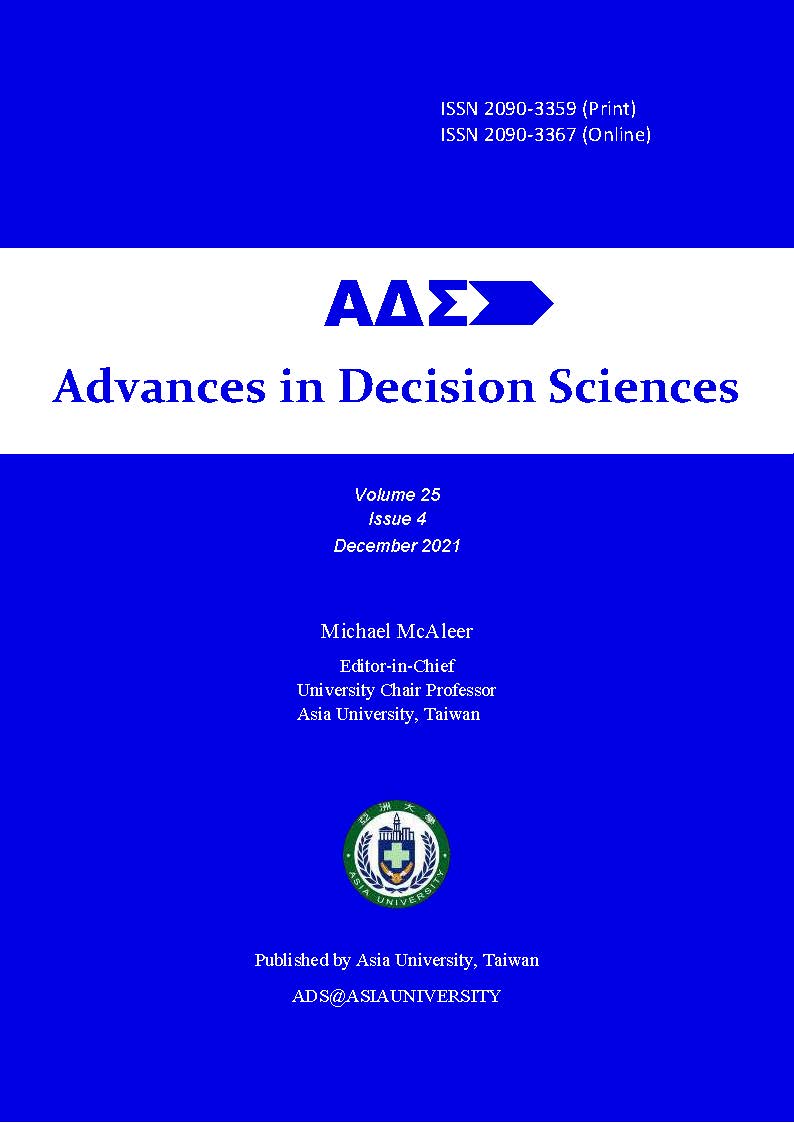Existence of Cointegration between the Public and Private Bank Index: Evidence from Indian Capital Market
DOI:
https://doi.org/10.47654/v25y2021i4p152-172Keywords:
Public Bank Index, Private Bank Index, Johansen’s Cointegration Test, Granger Causality TestAbstract
Purpose: The study aims to examine both long-run and short-run causal relationships among the public and private bank indices of the Indian capital market.
Design/methodology/approach: The paper employs Johansen's cointegration approach and Granger Causality test, which allows measuring long-run relationships and causality among the public and private bank indices.
Findings: The empirical analysis indicates that long-run cointegrating relationships exist between public and private bank indices. On the other hand, Granger Causality reveals that the private bank index plays a dominant role; Granger causes public bank index. So, long-run diversification may not be possible due to common factors; however, short-run portfolio diversification is possible due to unidirectional causality running from private bank index to public bank index.
Originality/value: Investors often create portfolios by allocating funds to public and private bank stocks based on the performance and projected development of the bank. In recent decades, there has been a surge in interest in banking sector unification. So, the transfer of information between private and public banks witnessed a boom. To fill this research gap, the study contributes to the literature by investigating the cointegration and causality between Nifty PSU Bank and Nifty PVT Bank indices in the Indian capital market.
Implications: The study's findings have implications for investors while maximizing return on investment when diversifying capital among public and private bank stocks. The findings significantly impact traders' judgments when using hedging and arbitration strategies, guide portfolio managers when managing risk, and help policymakers assess the market stability.
Keywords: Public Bank Index, Private Bank Index, Johansen's Cointegration Test, Granger Causality Test
JEL Classification: C58 N25 O16
References
Ali, J., & Gupta, K. B. (2011). Efficiency in agricultural commodity futures markets in India Evidence from cointegration and causality tests. Agricultural Finance Review, 71(2), 162–178.
Allen, D. E., Chang, C., McAleer, M., & Singh, A. K. (2017). A cointegration analysis of agricultural, energy and bio-fuel spot, and futures prices. Applied Economics.
Aravind, M. (2017). The Dynamic linkage among Sectoral Indices : Evidence from Indian Stock Market. Rajagiri Management Journal, 12(1).
Babu, G. S. (2014). A Comparative Study of Financial Performance Stability Of Two Private Commercial Banks (ICICI And HDFC) and Their Subsidiary Companies In India. International Journal of Business, Management and Allied Sciences, 1(3), 365–373.
Batareddy, M., Gopalaswamy, A. K., & Huang, C. H. (2012). The stability of long-run relationships A study on Asian emerging and developed stock markets (Japan and US). International Journal of Emerging Markets, 7(1), 31–48.
Bhatia, P., & Gupta, P. (2020). Sub-prime Crisis or COVID-19: A Comparative Analysis of Volatility in Indian Banking Sectoral Indices. FIIB Business Review, 9(4), 286–299.
Bhuvaneshwari, D., & Ramya, K. (2017). Cointegration and Causality between Stock Prices and Exchange Rate: Empirical Evidence from India. SDMIMD Journal of Management, 8(1), 31–38.
Chan, K. C., Gup, B. E., & Pan, M. S. (1997). International stock market efficiency and integration: A study of Eighteen nations. Journal of Business Finance and Accounting, 24(6), 803–813.
Chowdhury, M. A. F., & Masih, M. (2015). Socially responsible investment and Shariah-compliant investment compared: Can investors benefit from diversification? An ARDL approach. Munich Personal RePEc Archive Socially.
Cyano, P., Babu, M., & Hariharan, C. (2018). Impact of Digitalisation on Indian Banking Sector: An Empirical Study. International Journal of Scientific Research in Computer Science Applications and Management Studies, 7(5), 5–8.
Dickey, D. A., & Fuller, W. A. (1979). Distribution of the Estimators for Autoregressive Time Series With a Unit Root. Journal of the American Statistical Association, 74(366), 427.
Engle, R. F., & Granger, C. W. . (1987). Co-integration and Error correction: Representation, Estimation and Testing. Econometrica, 52(2), 251–276.
Gujarati, D. N. (2004). Basic Econometrics. In The McGraw-Hill Companies.
Gupta, R., & Guidi, F. (2012). Cointegration relationship and time varying co-movements among Indian and Asian developed stock markets. International Review of Financial Analysis, 21, 10–22.
Islam, K. U., & Goyal, M. M. (2017). Examining the Fisher Effect in Short and Long Run: A Study of NSE Sectoral Indices. International Journal of Financial Management, 7(2&3), 20–29.
Jagotra, S. (2018). Identifying Financial & Operating Issues and Measuring Systematic & Unsystematic Risks: A Study of Indian Banking Sector. International Journal of Banking, Risk and Insurance, 6(2), 46–53.
Johansen, S., & Juselius, K. (1990). Maximum likelihood estimation and inference on cointegration—with appucations to the demand for money. Oxford Bulletin of Economics and Statistics, 52(2), 169–210.
Kharbanda, V., & Singh, A. (2017). Lead-lag relationship between futures and spot FX market in India. International Journal of Managerial Finance.
Konanki, J., & Basaiah, P. (2018). A Study on Comparative Analysis of Risk and Return with Reference to Stocks of Bank Nifty. International Journal of Advance Research, Ideas And Innovations In Technology, 4(1), 66–76.
Lee, S. P., Isa, M., & Auzairy, N. A. (2020). The relationships between time deposit rates, real rates, inflation and risk premium The case of a dual banking system in Malaysia. Journal of Islamic Accounting and Business Research, 11(5), 1033–1053.
Lv, Z., Chu, A. M. Y., McAleer, M., & Wong, W. K. (2019). Modelling Economic Growth, Carbon Emissions, and Fossil Fuel Consumption in China: Cointegration and Multivariate Causality. International Journal of Environmental Research and Public Health, 16(21).
M, S. S., & Hemalatha, A. V. (2018). Comparative Study on the volatility of share price of private and public sector Banking Companies. Journal of Emerging Technologies and Innovative Research, 5(10), 138–149.
Meric, I., Ratner, M., & Meric, G. (2008). Co-movements of sector index returns in the world’s major stock markets in bull and bear markets: Portfolio diversification implications. International Review of Financial Analysis, 17(1), 156–177.
Mishkin, F. S. (1992). Is the Fisher effect for real?. A reexamination of the relationship between inflation and interest rates. Journal of Monetary Economics, 30(2), 195–215.
Mohan, T. T. R., & Ray, S. (2004). Productivity Growth and Efficiency In Indian Banking: A Comparison Of Public, Private, And Foreign Banks (Issue September).
Mohanty, B. K., & Krishnankutty, R. (2018). Determinants of Profitability in Indian Banks in the changeing scenario. International Journal of Economics and Financial Issues, 8(3), 235–240.
Moslehpour, M., Al-Fadly, A., Ehsanullah, S., Chong, K. W., Xuyen, N. T. M., & Tan, L. P. (2022). Assessing Financial Risk Spillover and Panic Impact of Covid-19 on European and Vietnam Stock market. Environmental Science and Pollution Research.
Narayan, P., & Reddy, Y. V. (2017). Exploring the Causal Relationship Between Stock Returns, Volume, and Turnover across Sectoral Indices in Indian Stock Market. Metamorphosis, 16(2), 122–140.
Nateson, C., Palanisamy, R., Renukadevi, P., & Suganya, D. (2013). Spillover Effect of Volatility in BSE Sensex on BSE Sectoral Indices. International Journal of Management & Business Studies, 3(1), 92–95.
Owyong, D., Wong, W. K., & Horowitz, I. (2015). Cointegration and Causality among the Onshore and Offshore Markets for China’s Currency. Journal of Asian Economics, 41, 20–38.
Patra, T., & Poshakwale, S. S. (2008). Long-run and short-run relationship between the main stock indexes: Evidence from the Athens stock exchange. Applied Financial Economics, 18(17), 1401–1410.
Phillips, P. C. B., & Perron, P. (1988). Testing for a unit root in time series regression. Biometrika, 75(2), 335–346.
Phiri, A. (2015). Asymmetric cointegration and causality effects between financial development and economic growth in South Africa. Studies in Economics and Finance, 32(4), 464–484.
Ramirez, M. D. (2000). Foreign direct investment in Mexico: A cointegration analysis. Journal of Development Studies, 37(1), 138–162.
Rastogi, S. (2013). Long-term Association of Stock Markets of Different Nations: An Empirical Study. Vision, 17(4), 303–313.
Ratanapakorn, O., & Sharma, S. C. (2007). Dynamic analysis between the US stock returns and the macroeconomic variables. Applied Financial Economics, 17(5), 369–377.
Rohith, U. J. (2017). A Study on the Volatility and Return with Reference to Stocks of Bank Nifty. Academia, 4(1), 66–76.
Saungweme, T., & Odhiambo, N. M. (2019). Inflation and Economic Growth in Kenya: An Empirical Examination. Advances in Decision Sciences, 23(December).
Saxena, M., & Kohli, A. S. (2012). Impact of Corporate Social Responsibility on Corporate Sustainability: A Study of the Indian Banking Industry. IUP Journal of Corporate Governance, 11(4), 39–54.
Sharma, Abhijit, & Panagiotidis, T. (2005). An Analysis of Exports and Growth in India: Cointegration and Causality Evidence (1971-2001). Review of Development Economics, 9(2), 232–248.
Sharma, Arun kumar. (2014). Relationship between the Selected Sectoral Indices and Nifty. International Journal of Business and General Managament, 3(3), 117–124.
Soni, T. K. (2014). Cointegration, linear and nonlinear causality: Analysis using Indian agriculture futures contracts. Journal of Agribusiness in Developing and Emerging Economies, 4(2), 157–171.
Vardar, G., Tunc, G., & Aydogan, B. (2012). Long-Run and Short-Run Dynamics among the Sectoral Stock Indices: Evidence from Turkey. Asian Economic and Social Society, 2(2), 347–357.
Wong, W. K., Penm, J., Terrell, R. D., & Lim, K. Y. C. (2004). The Relationship Between Stock Markets of Major Developed Countries and Asian Emerging Markets. Journal of Applied Mathematics and Decision Sciences, 8(4), 201–218.

Published
Issue
Section
License
Copyright (c) 2021 Advances in Decision Sciences

This work is licensed under a Creative Commons Attribution-NonCommercial 4.0 International License.







 Scientific and Business World
Scientific and Business World